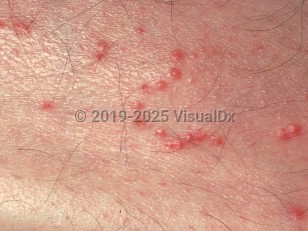Fire ant sting in Adult
Alerts and Notices
Important News & Links
Synopsis

Fire ants are stinging ants found worldwide. They live in large colonies in the ground and typically feed on plants, seeds, and small insects. Unlike most other ants that bite to kill their prey, fire ants bite to hold onto their prey, then inject a toxic alkaloid venom with their posterior sting. They can sting multiple times. Most species of fire ants do not come into contact with humans and, therefore, are not of medical significance. The exception is the red imported fire ant, Solenopsis invicta (RIFA). Native to South America, this ant has now spread to the southern and southwestern United States, eastern Australia, the Philippines, Taiwan, and China. In areas where red imported fire ants live, up to 60% of the human population is stung annually.
The sting of a fire ant causes an immediate painful, burning sensation (hence the name "fire" ants). Soon after, most victims develop an IgE-mediated wheal and flare reaction near the bite site. Within the next 24 hours, vesicles develop that are initially filled with clear fluid. The fluid then becomes cloudy, leaving a typical fire ant lesion that is an umbilicated, sterile pustule on a red, erythematous base. These pustules may persist up to 10 days but will eventually rupture, form a crust, and sometimes leave a scar. Secondary infection can occur when pustules rupture.
Fire ant venom is mainly composed of piperidine alkaloids, which cause histamine release and necrosis of human skin. A very small percent (0.1%) of the venom is composed of allergens that can induce an IgE-mediated reaction and may be cross-reactive with bee and wasp venom. Allergic reactions are common, but anaphylaxis is rare (< 1%-2%). Death from massive stinging events (5 000-10 000 stings) can occur, typically in victims who are incapacitated, such as invalids or intoxicated individuals.
Anaphylactic reactions cause diffuse urticaria, pruritus, angioedema, bronchoconstriction, respiratory distress, hypotension, loss of consciousness, and cardiac arrhythmias. Typically, onset of life-threatening, anaphylactic signs occur within 10 minutes of the sting.
Systemic reactions including seizures, peripheral neuropathy, serum sickness, nephropathy, and worsening of cardiopulmonary disease have been reported in individuals with numerous stings or those with manifestations of anaphylaxis.
The sting of a fire ant causes an immediate painful, burning sensation (hence the name "fire" ants). Soon after, most victims develop an IgE-mediated wheal and flare reaction near the bite site. Within the next 24 hours, vesicles develop that are initially filled with clear fluid. The fluid then becomes cloudy, leaving a typical fire ant lesion that is an umbilicated, sterile pustule on a red, erythematous base. These pustules may persist up to 10 days but will eventually rupture, form a crust, and sometimes leave a scar. Secondary infection can occur when pustules rupture.
Fire ant venom is mainly composed of piperidine alkaloids, which cause histamine release and necrosis of human skin. A very small percent (0.1%) of the venom is composed of allergens that can induce an IgE-mediated reaction and may be cross-reactive with bee and wasp venom. Allergic reactions are common, but anaphylaxis is rare (< 1%-2%). Death from massive stinging events (5 000-10 000 stings) can occur, typically in victims who are incapacitated, such as invalids or intoxicated individuals.
Anaphylactic reactions cause diffuse urticaria, pruritus, angioedema, bronchoconstriction, respiratory distress, hypotension, loss of consciousness, and cardiac arrhythmias. Typically, onset of life-threatening, anaphylactic signs occur within 10 minutes of the sting.
Systemic reactions including seizures, peripheral neuropathy, serum sickness, nephropathy, and worsening of cardiopulmonary disease have been reported in individuals with numerous stings or those with manifestations of anaphylaxis.
Codes
ICD10CM:
T63.421A – Toxic effect of venom of ants, accidental, initial encounter
SNOMEDCT:
403141006 – Ant sting
T63.421A – Toxic effect of venom of ants, accidental, initial encounter
SNOMEDCT:
403141006 – Ant sting
Look For
Subscription Required
Diagnostic Pearls
Subscription Required
Differential Diagnosis & Pitfalls

To perform a comparison, select diagnoses from the classic differential
Subscription Required
Best Tests
Subscription Required
Management Pearls
Subscription Required
Therapy
Subscription Required
References
Subscription Required
Last Updated:02/20/2018
 Patient Information for Fire ant sting in Adult
Patient Information for Fire ant sting in Adult
Premium Feature
VisualDx Patient Handouts
Available in the Elite package
- Improve treatment compliance
- Reduce after-hours questions
- Increase patient engagement and satisfaction
- Written in clear, easy-to-understand language. No confusing jargon.
- Available in English and Spanish
- Print out or email directly to your patient
Upgrade Today

Fire ant sting in Adult

